Guide to SI1 Clarity Diamonds
What you need to know about Si1 diamond clarity and why its our favorite clarity grade
What you need to know about Si1 diamond clarity and why its our favorite clarity grade
Are you considering an SI1 clarity diamond for your engagement ring but unsure about its quality? SI1, or Slightly Included 1, is a grade on the diamond clarity chart indicating that the diamond has minor inclusions, often invisible to the naked eye.
When shopping for an SI1 diamond, it is important to look for an eye-clean diamond. Inspect the diamond certificate clarity plot to understand the types and locations of the inclusions. Look for inclusions that can be easily covered by the ring setting or prongs.
In this guide, we’ll explore what SI1 clarity means, how it compares to other clarity grades, and provide tips to ensure you choose a beautiful SI1 clarity diamond that offers excellent value for your money.
What are SI clarity diamonds?
What is an SI1 clarity diamond?
What is the difference between SI and VS diamonds?
Clarity plots on SI1 diamonds
When to buy SI1 diamonds?
Are SI1 diamonds eye-clean?
What tips should I follow to get a beautiful SI1 clarity diamond?
Where is the best place to buy an SI1 clarity diamond?
FAQs
Why you should trust us
When buying a diamond, you’ll need to consider its clarity—one of the 4 C’s of diamonds. Clarity refers to the blemishes and inclusions a diamond has. Most diamonds on the market are included, meaning there are small blemishes or imperfections in the stone. Some of these flaws are visible, while others are microscopic.
This is a great SI1 clarity diamond from James Allen for $4,670. You can save some money if you find a fantastic lower clarity diamond like this SI2 clarity diamond from James Allen that saves 16%. But if you go too far, you may end up with an SI2 like this one. True it saves you 25%, but it’s horrific looking and not worth spending any money on.
In evaluating diamonds, you want to find an eye-clean stone without overpaying. As an example, both VS1 and SI1 diamonds can be eye-clean, but the VS1 diamond will be much more expensive. To demonstrate, this 0.90 carat I color VS1 diamond from Blue Nile costs $2,950, while this 0.90 carat I color SI1 diamond also from James Allen costs $2,200. With the other characteristics of the diamonds being identical, the SI1 diamond is 25% cheaper. Both diamonds are eye-clean, but if you choose the VS1 diamond, you’ll pay $750 more.
As shown in the example, an SI1 diamond can save you a good chunk of your budget. But choosing an SI1 diamond isn’t always a good move. Depending on the carat weight, shape, and particular imperfections in the diamond, an SI1 might not always be eye-clean. In some cases, VS2 clarity grade is the least expensive, eye-clean option.
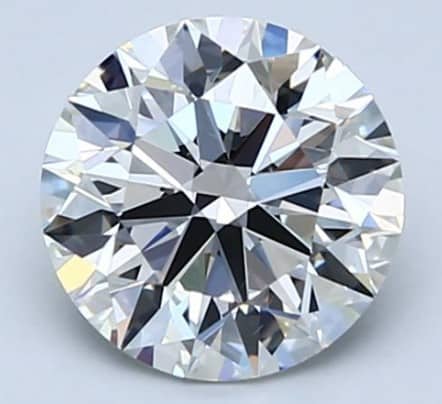
In this post, we’ll break down how to know when to choose an SI1. We’ll also include buying tips so you know exactly what to look for. For individual questions about diamond clarity, reach out to our experts.
SI diamonds are diamonds given a grade of SI1 or SI2 from the diamond clarity chart. This indicates the diamond is “Slightly Included”, and any inclusions or imperfections are quite easy to spot under magnification. And how are these grades determined? According to the GIA laboratory, “Evaluating diamond clarity involves determining the number, size, relief, nature, and position of these characteristics, as well as how these affect the overall appearance of the stone”.
SI diamonds come in towards the lower end of the grading scale for clarity. However, an SI clarity grade does not necessarily imply a low-quality diamond. Many SI diamonds appear clean to the naked eye, and therefore make a great purchase for an engagement ring.
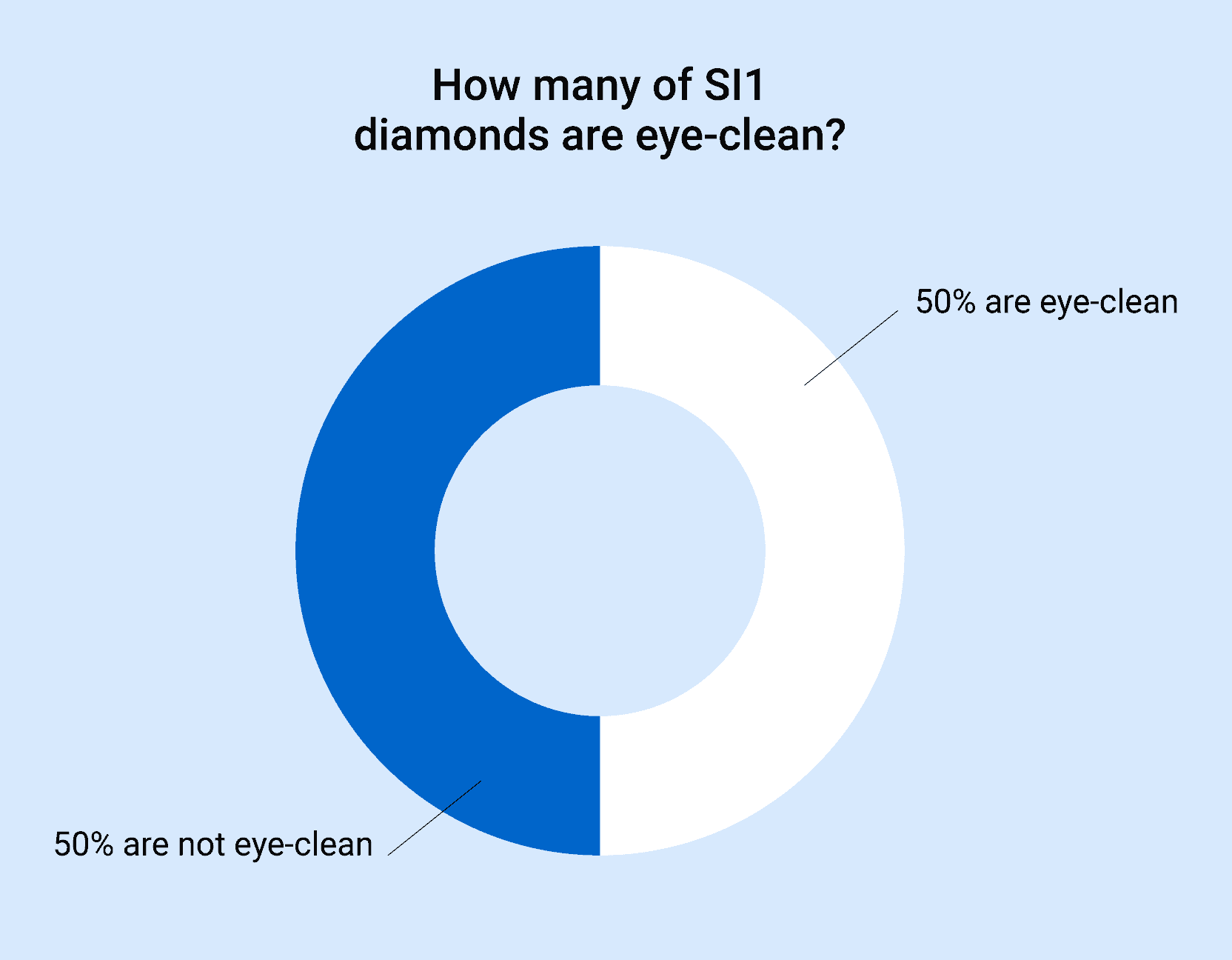
The tier above SI in diamond clarity is VS, or Very Slightly Included. VS clarity can be either VS1 (the highest of VS clarity grades) or VS2, depending on the size and frequency of the inclusions.
Most times, you’ll be choosing between SI and VS diamonds when you’re shopping for a diamond ring. That’s because this is the range in which most diamonds are clear and free of any noticeable inclusions under normal viewing conditions. Once you’re at this level, any grades higher are just going to command a bigger price tag with no visible difference.
When comparing a SI vs VS diamond, see if either diamond has any blemishes or inclusions you can see when viewing it normally. If both diamonds appear clean, you can choose the SI diamond and usually save a decent amount of money on your ring.
SI1 clarity diamonds are Slightly Included to the 1st degree, meaning inclusions can be found with a standard jeweler’s loupe at 10x magnification. With most diamond shapes, SI1 clarity inclusions are almost always eye-clean, meaning you can’t see the imperfections with the naked eye.
In some diamonds, however, you might be able to notice flaws without magnification. The size, color and location of the inclusions play into how noticeable they are. That’s why you need to review each diamond closely. In SI1 diamonds, watch for inclusions like clouds, feathers and crystals. Looking at the diamond up-close with HD imagery, like on James Allen’s site, you’ll be able to tell if the diamond is eye-clean.
The GIA—the most respected lab grading entity—ranks diamonds on a clarity scale from best to worst.
The scale is as follows: Flawless (FL), Internally Flawless (IF), Very Very Small Inclusions 1 (VVS1), Very Very Small Inclusions 2 (VVS2), Very Small Inclusions 1 (VS1), Very Small Inclusions 2 (VS2), Small Inclusions 1 (SI1), Small Inclusions 2 (SI2), Inclusions 1 (I1), Inclusions 2 (I2).
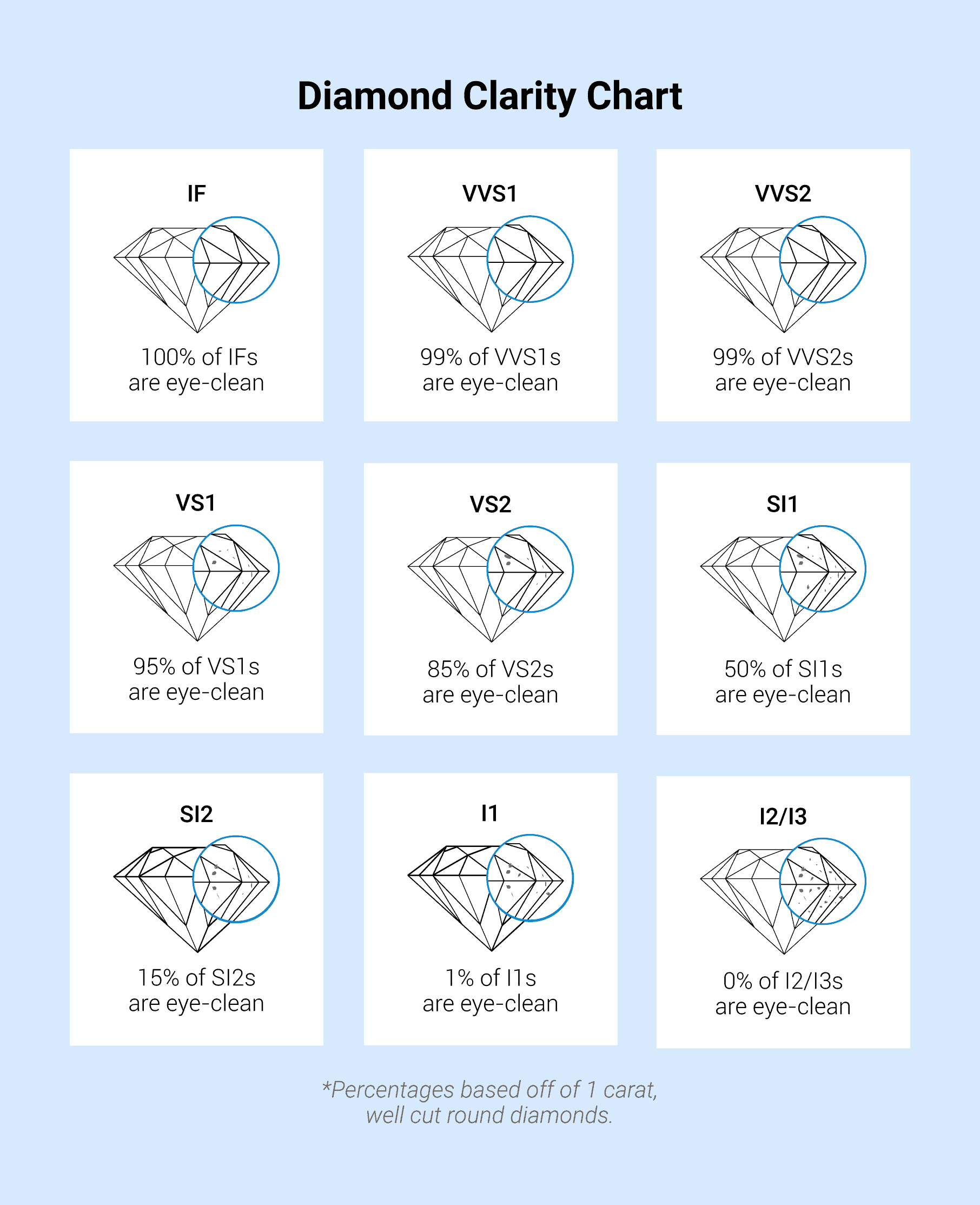
While it may seem like buying a flawless diamond would be the best choice, it isn’t necessary. Because imperfections above the SI2 grade are hard to see, you’re essentially overpaying by choosing a better clarity grade. And sometimes the price difference is significant.
Clarity grades are determined by the size and harshness of inclusion in relation to the size of a diamond. The grade itself does not tell you whether the inclusions will be noticeable to the naked eye. For example, this 1/2 carat SI1 diamond from Blue Nile has a couple of small grey inclusions visible under the magnification in the image. But if that diamond were on someone’s finger, you would not see that inclusion. On the flip side, take a look at this 3 carat SI1 diamond from Blue Nile. The inclusion is similar to the one in the half-carat diamond (in composition and in its size in relationship to the size of the diamond) but it would be readily visible to the naked eye.
This is important to take into account when reading about clarity grades. This should not scare you off of SI1 grade diamonds. Here is an absolutely eye-clean 3 carat diamond with an SI1 clarity grade from Blue Nile. You just need to understand that the clarity scale is not black and white.
In most cases, if you can find an SI1 diamond that’s eye-clean, it will give you better value over a VS2. While VS2 means very slightly included and SI1 means slightly included, they’re both often eye-clean—meaning there won’t be any noticeable blemishes and inclusions.
Let’s put two diamonds next to each other for comparison. Take this eye-clean 1 carat H color SI1 oval Cut diamond from James Allen. It costs $3,850. This 1 carat eye-clean H color VS2 oval cut diamond is also eye-clean but costs $4,440. The color grade is higher, but everything else is the same, and it costs over 15% more. And if you’re looking at SI1 diamonds vs VVS diamonds, the price difference will be even more significant.
With two eye-clean diamonds side-by-side, no matter their clarity grade, you won’t be able to tell the difference unless you’re looking at the diamond under magnification (which isn’t something you’re likely to do with an engagement ring).
Looking at the two diamonds below, can you tell which one is the VS2 and which one is the SI1?
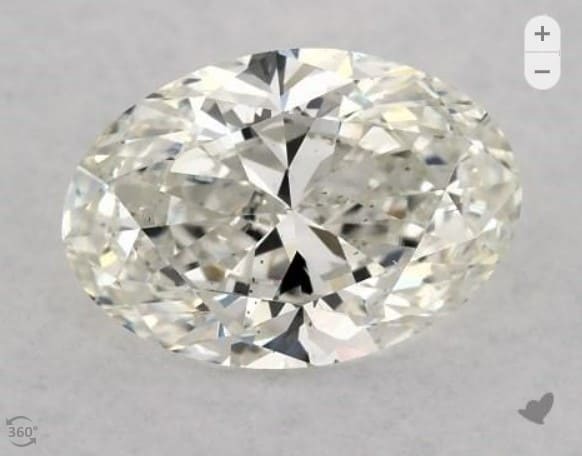
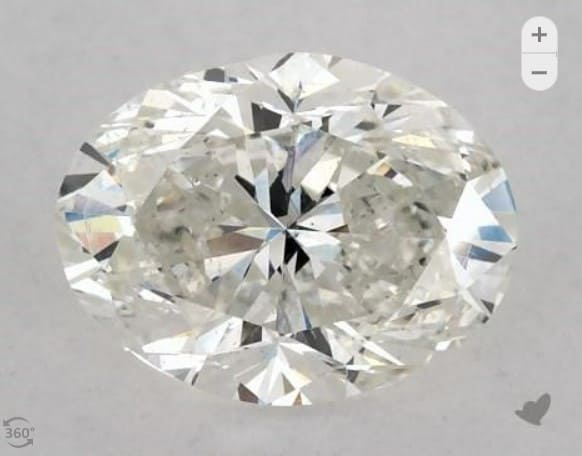
(The top diamond is the VS2, and the bottom is the SI1.)
This is why a grading report with a clarity grade isn’t enough to make a judgment on whether you should buy the diamond. Take advantage of vendors like James Allen that provide 360° HD imagery.
When you receive a GIA certificate with your diamond, it’ll probably come with a clarity plot (especially if it’s over 1 carat). A clarity plot is a mapping of all of the imperfections in the diamond, including the surface blemishes and internal inclusions. It will show you where and what type of inclusions are present. Because SI1 diamonds are slightly included, the map should have inclusions on it. If the clarity plot of an SI1 diamond doesn’t show anything, there is usually a hidden flaw that affects the clarity grade – there must be a reason why a diamond gets an SI1 grade (e.g. check the comments for “Clarity based on clouds that aren’t shown.” or similar.)
With the clarity plot, notice the locations and type of inclusions. For example, you’ll want to see if the inclusions are near the edge of the stone. If you’re putting the diamond in a pronged setting, it’s likely the inclusions will be covered. If there’s a large inclusion in the center of the table, then the diamond probably isn’t the best purchase.
SI1 diamonds will give you the best value for your money in a few scenarios. Here’s a breakdown of the shapes that will usually be eye-clean at the SI1 clarity grade.
Round cut, princess cut diamonds: An SI1 or VS2 clarity will typically give you an eye-clean diamond. For large diamonds, we recommend a VS1 or VS2 grade, because the larger the diamond, the easier it is to see inclusions.
Oval cut, cushion cut, radiant cut, marquise and pear shapes: These diamonds hide inclusions better than other shapes, so choose an SI1 or even an SI2 diamond to get the best value.
Heart shaped diamonds: Opt for an SI1 or VS2 clarity grade, because heart shape diamonds hide inclusions better than round cuts, but not as well as shapes like the cushion cut or oval.
Not asscher cuts, emerald cuts and baguettes: Step cut diamonds show imperfections easier. Go with a VS2 in these diamond shapes for the best value.
You can use clarity grades to get an idea of a diamond’s appearance, but the most important thing should always be to find a diamond that appears “eye-clean”.
When a diamond is eye-clean, it appears clear of any perfections under normal viewing conditions. It may be slightly included if you look at it with a magnifying glass or a loupe, but when it’s set in a ring and on someone’s finger, these inclusions can’t be seen.
As long as a diamond is eye-clean, there is no need to go any higher in clarity grade. Your aim should be to find the cheapest (in regards to clarity – other factors matter as well) eye-clean diamond you can, so you don’t pay more than you need to for clarity.
In many diamond shapes, an SI1 diamond will often be eye-clean. Round cut diamonds under 1 carat tend to be eye-clean with an SI1 clarity grade. The same goes for cushion cuts, princess cuts, oval cuts, radiant cuts, marquise and pear shapes. For emerald cut, asscher cut (and baguette) diamonds, you’ll probably need to go with a VS2 grade to get an eye-clean stone.
You can’t go by grade alone to ensure a diamond is eye-clean, however. It’s important to inspect every diamond thoroughly to be sure this is the case. We developed Ringo, a patented artificial intelligence model, to help you do this.
Ringo can examine videos of diamonds to determine whether or not they are eye-clean, as well as filter for parameters such as cut quality, fluorescence issues, and your choice of setting style.
If you want to select a diamond specifically for your personal needs (budget, shape and setting style), check it out here.
When you shop for diamonds, you’ll have hundreds or thousands of SI1 diamonds to look at. How do you know which SI1 diamond to choose? Follow the expert tips below.
This is the most important part of evaluating the clarity of any diamond. Look at the diamond closely using high-tech online imagery. Do you see any imperfections in the stone? If not, it’s eye-clean. If you notice imperfections, it depends on the location and size of them. If a vendor doesn’t have sufficient photos, choose a site that does, like Blue Nile or James Allen.
Diamonds that are 1 carat or larger should come with a clarity plot on their lab report. You can see exactly where the inclusions are and what type they are.
A trick to buying beautiful SI1 diamonds is to find one with inclusions that are spread out. Look out for inclusions that blend into the rest of the diamond or will be covered by the ring setting or prongs.
The most obvious inclusions will be dark crystals underneath the table. They look like dust specks that you can’t get rid of. Cloud inclusions, like a cluster of tiny dots, can make the diamond look hazy (hence the cloud name). A feather is a small crack that can impact light reflection, but not if it’s near the bottom of the diamond’s culet (not too close, though). Tiny or faint blemishes won’t be nearly as noticeable as dark ones.
Some diamond shapes hide inclusions well, but not all. The above section “When SI1 diamonds are the best value” gives you a guide on each diamond shape.
The GIA is the most reliable lab entity in the industry. You can trust an SI1 diamond from one of these labs because they grade consistently. An SI1 diamond from the EGL or IGI, for instance, won’t mean as much. Because these labs grade inconsistently, an SI1 diamond might actually be an SI2 or an I1 diamond.
An SI1 diamond can be the best value, depending on the carat weight, shape of the diamond, and the location and type of inclusions. Reviewing a diamond up-close will help you determine if the diamond is eye-clean. If an SI1 diamond is eye-clean, it’s a great purchase because you get a diamond that won’t have any visible imperfections and you aren’t paying for the higher price of a better clarity grade.
The price for an SI1 clarity diamond depends on many additional factors, including its diamond cut, carat weight, shape and diamond color.
Well-cut 1 carat round diamonds with SI1 clarity and a G-I color can range from $4,000-$5,500. You can expect the diamond price per carat to be bigger or smaller depending on the size of the diamond. A 0.50 carat SI1 clarity diamond, factoring in the same shape and color range, will cost around $900-$2000. While a 2 carat SI1 diamond will cost in the range of $12,000 to $25,000.
You can expect to pay a little less than this for any non-round diamond shape.
To search for an SI1 clarity diamond, check out James Allen or Blue Nile. There are several reasons why these two vendors are the best places to buy SI diamonds.
First, both vendors have high-quality images and inspection tools to help you determine whether the diamond you’re about to buy is eye-clean or not. As we already established, this is vital when looking for an SI1 diamond, and buying a diamond without properly inspecting it first can be a huge mistake.
Second, James Allen and Blue Nile both offer a huge range of diamonds, which will increase the chances that you find a high-quality SI1 diamond in your preferred style. All their diamonds come graded by the GIA or AGS.
Finally, both offer a stellar customer service experience, with a lifetime warranty, free returns, and better value for money than anywhere else you’re likely to find, online or from a brick-and-mortar store.
SI1 diamonds are usually eye-clean, meaning they do not have any inclusions that are easily visible to the naked eye. This varies from diamond to diamond, however, so be sure to inspect each diamond individually.
SI1 is one grade lower on the clarity scale than VS2. However, if you can find an SI1 diamond that is eye-clean, this will be a better purchase than a VS2 diamond, as it will be cheaper, but with little visible difference in quality.
Many SI1 diamonds are very good, high-quality diamonds, as long as they appear clean to the naked eye.
A nice one carat round diamond that is SI1 clarity costs about $4,400. The price can vary a bit based on which shape you select, what color grade you go with, and whether it’s well cut or not.
Assessing diamond clarity can be challenging, particularly if you have no prior experience with diamonds. That’s why our experts are here to help.
Every diamond should be carefully inspected to ensure its inclusions can’t be noticed by the naked eye. By taking the time to look for an eye-clean stone, you can get amazing value with an SI1 diamond, and avoid paying extra for an unnecessarily high clarity grade.
When you’re ready to start your search, feel free to reach out to our experts. We’ll help you sift through the options to pick out an eye-clean diamond at the best price.




Before you buy a diamond, get personal buying advice from industry veterans. We'll help you get the best diamond for the money.
DISCLAIMER: We don't use your email for marketing. Period.
A diamonds’ price is determined primarily by the 4 Cs of the diamond. On the wholesale level, diamond prices are first based on a diamond shape and
Buying an engagement ring is often one of the first major purchases in a person's life. The process can be fraught with tension as there are so m
A wide range of 1 carat diamonds exist both in online markets and local diamond jewelry stores. Not only are there significant differences in beauty
Please enter your email address to receive your 25% off coupon code:
Here is your coupon code: GFDSF3GF